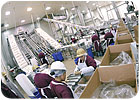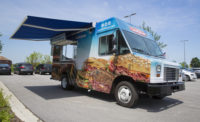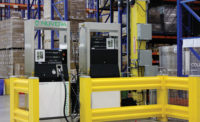
OSI's Oakland Foods plant was purchased in 1996 as an expansion site for the OSI network. Today it is the company's largest plant at 350,000 square feet.
Built into the side of a hill, OSI Group’s Oakland Foods processing plant looks deceivingly small as you approach it along U.S. Highway 59. That’s because the bulk of this 350,000-square-foot protein processing facility’s roof is flush with the grass that meets the highway - giving the building’s exhaust stacks the appearance of coming straight out of the ground.
If you happened to be driving through Oakland, Iowa - about 40 miles outside Omaha, Neb.-- you probably wouldn’t realize that this building is, in fact, a facility that processes more than 250 varieties of cooked meat products for many of the food industry’s largest international foodservice and retail players.
As the saying goes, appearances can be deceiving.
This versatile plant processes approximately 150 million pounds of food items per year, ranging from all-natural beef hot dogs to ready-to-eat bacon to a teriyaki flavored sausage patty for export (for a more detailed breakdown see “At a glance” sidebar below). But you won’t find any of these products emblazoned with an OSI or Oakland Foods insignia. Instead, the Oakland plant has established something else as its hallmark.
“Food safety and quality are our brand,” says Mike Koranda, Oakland’s general manager. “Since we’re a contract-manufacturer, we don’t have a brand.”
Dan Milovanovic is OSI’s senior vice president of North American operations as well as a former general manager of the Oakland Foods plant.
“I think food safety is what gives us our competitive edge in the industry,” Milovanovic says. “If you come to OSI, you can be confident that you are going to have products produced in facilities with leading edge quality and food safety systems. I don’t think that you can say that about all manufacturing companies.”
Visitors to the plant will find evidence of Oakland’s commitment to quality and safety throughout the facility. Whether it’s the banners proclaiming the company’s employee safety program slogan - L.I.F.E. (Live Injury Free Everyday) - or the safety trophies and certifications displayed on the shelves in the conference room, or the quality assurance associates checking product for color, weight, shape and other customer specifications on the plant floor - it’s clear that quality and safety are taken seriously here.
“It all comes down to focus,” Milovanovic says. “And the guy at the corner has to be the one that is driving that focus,” he adds while nodding at Koranda. “Some plants don’t evolve into this - leadership has to ensure continued focus on quality along with food and employee safety.”
And if there’s one person who knows everything about Oakland’s evolution, it’s Milovanovic. A former Oakland plant manager (2000-2004), Milovanovic led the OSI team that first discovered the Oakland facility in 1996.
“At first, we thought it was too big,” he says of the former 300,000-square-foot slaughterhouse that sits on 90 acres of farmland, but OSI decided to buy the space and grow into it.
“We started from scratch. All that was left was the shell of the building. We put in new drains, walls, plumbing, electrical - it all had to be replaced,” Milovanovic says. “We had it up and running in six months.”
Today, the operation has grown to occupy nearly every corner of the facility - and it’s seen at least four expansions in as many years.
“We have continued to invest in this plant over the last four years,” says Koranda, who then ticks off some of the most recent improvements including a new packaging line for the ground and formed, fully-cooked beef, pork and poultry lines; three new microwave bacon lines (two put in last August); and a back building that contains a raw material and bacon cooler.
Another recent Oakland addition harks back to OSI’s food safety and quality “brand” and is a particular source of pride for both Koranda and Milovanovic.
“We installed X-ray machines about a year ago,” Koranda says. “They can detect everything - metal, bone, hard plastic, wood chips, etc.”
Bacon lines and hot dog lines have been equipped with two different types of X-ray machines. “The X-ray on the hot dog line also checks weight of the product to make sure they meet customer specs,” Koranda adds. These X-ray machines are just one part of Oakland’s impressive food safety program.
“Additionally, we’ve upgraded all our spiral freezers - lifting them up on pedestals - they’re actually elevated so that you can wash underneath,” says Milovanovic.
He also adds that metal seams on freezers and other equipment have been completely welded to provide a smooth cleaning surface. In addition, all of Oakland’s new equipment is designed to be easily broken down for cleaning.
“Food safety and employee safety come before everything else,” Koranda notes.
To that point, Oakland’s injury incidence rate continues to improve and exceed internal goals. Koranda says the plant falls in the top 5 percent of the overall industry in terms of employee safety.
These safety efforts and accomplishments have not gone unrecognized.
“We’re very proud of the fact that we’ve won OSI’s internal safety award seven years in a row - and hopefully this year will be number eight,” Koranda says. The OSI safety award is based on a four-day audit led by the company’s corporate safety manager and is awarded to one plant in each of the company’s three zones.
In addition to OSI’s internal audits, Oakland’s managers say working with food industry leading brands means being held to each company’s high quality and food safety standards.
“We go through as many as 12 independent quality audits a year because of our strategic co-manufacturer role,” Koranda says.
The plant also is completing all the pre-requisites to apply for the Occupational Safety and Health Administration Voluntary Protection Program or VPP Star Program in the next year. If successful they would be the first meat plant to do so in the state of Iowa.
While plant management, Koranda and plant Division Managers, Cheryl Goff and Jim Svajgl, undoubtedly deserve credit for these considerable safety achievements, Koranda points to Oakland’s approximately 700 employees for keeping things in safe working order.
“Our management team wouldn’t be anything without the people who work for us. Everything happens because of their efforts,” he says.
Soon, Koranda, Goff and Svagl will have a new space to communicate with plant workers - many of whom drive at least 40 miles from Omaha or Council Bluffs, Iowa, to work here. A new training room that seats 80 people currently is under renovation. Here, plant management and workers will discuss Oakland’s Manufacturing Execution System (MES). The MES system utilizes CAT2 software to record and measure data including: employee safety, HACCP checks, quality, costs, productivity, customer service, delivery and overall results.
“The data derived from this system is what we will use to drive future improvements,” Koranda explains. “We just want to keep improving. We believe very strongly in continuous improvement.”
Adds Milovanovic, “We’re looking into different ways to maximize our line efficiencies and take out our bottlenecks. There are a lot of things that you can do to increase capacity that doesn't necessarily mean getting a new building or a new line. It’s all about optimizing your current lines to give you more.”
AT A GLANCE
OSI Group’s Oakland FoodsAddress:21876 North Highway 59
Oakland, Iowa 51560
General information
General manager: Mike Koranda
Employees: Approximately 700
Products: Between 250 to 275 different SKUs, including: hot dogs, bacon, sausage links and patties, beefsteak, meatballs, burgers, bratwurst, bacon bits, Salisbury steak, nuggets, meatloaf
Volume: Approximately 150 million pounds per year
Makin' bacon
A step-by-step look at how OSI’s Oakland Foods facility processes bacon for both foodservice and contract manufacturing.PREPARATION:
First, pork bellies are brought in and trimmed. Next, the bellies are fed through an injector where needles penetrate the meat and inject brine. O-rings on the needles ensure that brine sprays sideways and is evenly dispersed throughout the pork.
Next, workers manually push metal combs into the bellies and they are hung on stainless steel trees. The stainless steel trees then are wheeled into a smoker for further processing. Depending on the type of bacon being made that day, the bellies stay in the smoker for as short as 90 minutes or as long as six hours.
When the smoked bellies are rolled out of the smokers, workers remove the combs and feed the bellies into a roller press. The roller press flattens and presses the bellies into more streamlined shapes. Next, the bellies are fed through a trimmer where the sides are sliced off. Bellies then travel in the opposite direction through a trimmer that docks the ends to create a flat edge. The leftover pieces are poured into a barrel to be sold to another plant or processed into bacon bits at Oakland. Next, the bellies are put into boxes and held in a cooler at 20ºF for two to five days.
PROCESSING:
Pork bellies are brought to a slicing line. Workers manually feed bellies through vertical slicers. Bacon slices then transfer into another room and through a microwave oven in which they are cooked (raw and cooked product are kept separate and are processed in different rooms). As the bacon conveys out of the oven it passes over an interlever that counts each slice and is programmed to distribute slices in counts of eight, 10 or 12 on sheets of paper. On this day, bacon slices automatically are placed eight to a sheet.
The bacon slices then convey through a nitrogen chiller tunnel. As the bacon passes out of the tunnel, it is checked by a quality assurance worker to ensure that weight, size and other customer specifications are on target.
PACKAGING:
Next, workers manually stack bacon sheets in stacks of eight. The bacon stacks then travel to the other side of the room where two workers manually place them into pouches. The bacon packs then pass through a machine which removes the air and seals the package. Lastly - before being boxed - the sealed bacon packages go through an X-ray machine where they are checked for contaminants, such as hard plastic, metal and bones. After being boxed, bacon packages are placed in a freezer until they are shipped out frozen.

